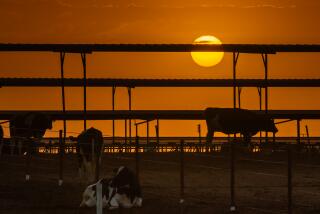Japanese Negotiators Agree to Drop Ban on U.S. Beef
- Share via
Japanese trade negotiators in Tokyo agreed Saturday to reopen their markets to U.S. beef, 10 months after discovery of a single case of mad cow disease in Washington state prompted Japan to ban American imports.
The deal was seen as the first step toward reestablishing the export market for U.S. beef -- which totaled more than $3.8 billion in 2003, but essentially disappeared at the end of December. That’s when more than 40 countries stopped importing U.S. beef because of concerns over mad cow disease.
Prior to the bans, Japan was the largest foreign market for U.S. beef. Encouraged by Saturday’s deal, U.S. negotiators planned to open talks with other countries, starting this week with South Korea.
“This is a very important milestone in our returning to normal,” said Agriculture Secretary Ann M. Veneman.
Ranchers and meatpackers applauded the agreement, but the chief economist at the National Cattlemen’s Beef Assn. cautioned that the U.S. cattle industry would take a while to snap back.
“This doesn’t mean the United States will instantly regain the same market share in Japan that we had,” said Gregg Doud. “We have a lot of work to do to regain our position as the leader in this market.”
Japan will resume buying U.S. beef after its Food Safety Commission revises regulations governing beef testing. J.B. Penn, U.S. agriculture undersecretary for farm and foreign agricultural services and the chief U.S. negotiator in Tokyo, said U.S. exports could resume in “a matter of weeks.”
As part of the deal, the United States agreed to resume importing specialty beef from Japan, which was banned after Japan’s first case of mad cow disease was discovered in 2001. After that discovery, Japan began testing all its beef cattle, and it has now confirmed 14 cases of the disease -- all in animals older than 20 months.
Saturday’s agreement initially calls for U.S. beef sales only from animals that were 20 months or younger at the time of their slaughter -- a provision that could benefit California ranchers and packing houses.
“The big packing houses here have a lot of cattle under 20 months and we should be able to send quite a lot of that beef to Japan,” said Bill Brandenberg, a partner in Brawley Beef, a big feed lot and packing house operator in Imperial County.
Harris Ranch Beef Co. has about 100,000 head of cattle on its feed lot in Coalinga, and most are younger than 20 months, said owner John Harris. He said the ranch had “good documentation” on the age of its cattle, which should help the company get its beef over any bureaucratic trade hurdles.
Still unclear, though, was the deal’s effect on domestic beef prices.
Harris said increased demand for U.S. beef could help bolster prices at a time when some feared they might start to soften. Beef prices tumbled after the discovery of an infected Holstein in Washington state last year, but they have largely recovered in the months since.
Fed cattle sells for about $87 per 100 pounds, down $4 from the robust market prior to the discovery.
A historically low domestic cattle herd of 95 million has helped keep supplies in check and prices firm.
But in recent weeks the supply of mature beef cattle ready for slaughter has started to grow, and without new demand, prices would start to soften, Harris said.
Mad cow disease, known formally as bovine spongiform encephalopathy, or BSE, creates holes in the brain, giving it a sponge-like appearance.
Scientists believe that there is strong evidence that eating contaminated meat causes a human form of BSE, known as variant Creutzfeldt-Jakob disease, which had affected 153 persons worldwide, most of them in Britain, as of the end of last year.
The disease in humans has no treatment and is fatal.
*
Hirsch reported from Los Angeles and Fiore from Washington.
More to Read
Inside the business of entertainment
The Wide Shot brings you news, analysis and insights on everything from streaming wars to production — and what it all means for the future.
You may occasionally receive promotional content from the Los Angeles Times.











